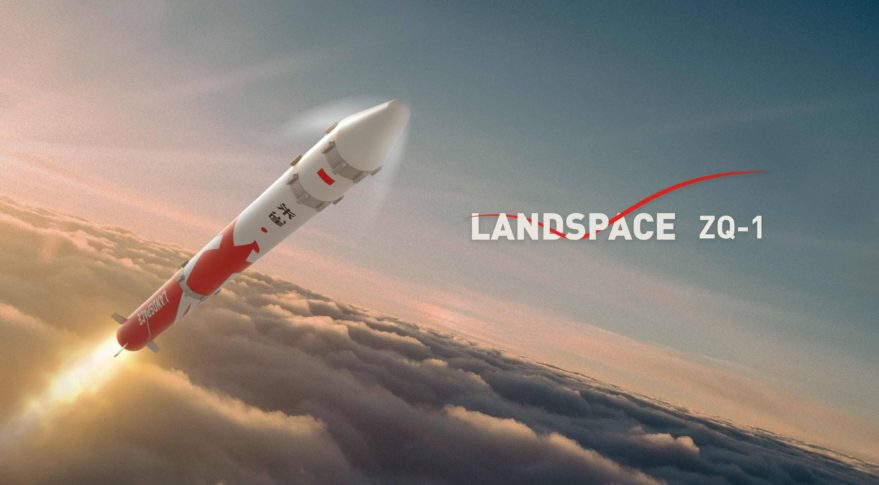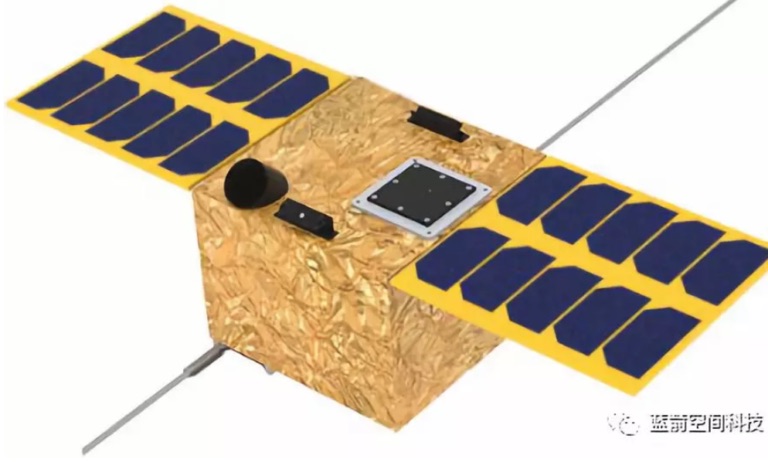Landspace of China to Launch First Rocket in Late 2018

HELSINKI — Emerging private Chinese company Landspace is set to launch its first rocket into orbit in the final quarter of 2018, carrying a small satellite for a state television company.
Landspace announced Aug. 2 that the three-stage solid-propellant LandSpace rocket, named Zhuque-1, will carry the China Central Television (CCTV) satellite for space science experiments and remote sensing before the end of the year.
It is expected to be China's first private orbital launch with the privately developed satellite to operate for two years in a Sun-synchronous orbit (SSO). Measuring 320 by 295 by 248 millimeters, the satellite is roughly the size of a three-unit cubesat. [China Joins Private Space Race with Landmark OneSpace Rocket Launch]

Zhuque-1 is a 19-meter-tall, 1.35-meter-diameter rocket with a takeoff mass of 27 metric tons and thrust of 45 tons, able to carry 200 kilograms to 500-kilometer SSO and 300 kilograms to a 300 kilometers low Earth orbit.
No launch site was named in the Aug. 2 press release but a contract signed by Danish cubesat maker Gomspace and Landspace for a rideshare service in 2018 previously identified the Wenchang Satellite Launch Centre, China's new coastal launch site, as the location for Landspace's debut launch.
Beyond this demonstration, Landspace has much grander plans. Last month the company said it had designed a methane- and liquid-oxygen-powered rocket it aims to test launch in 2020.
The two-stage Zhuque-2 (ZQ-2) rocket will measure 48.8-meters tall with a diameter of 3.35 meters and be capable of delivering a 4,000-kilogram payload capacity to a 200-kilometer low Earth orbit and 2,000 kilograms to 500-kilometer SSO, using 80-ton and 10-ton methane engines.
Get the Space.com Newsletter
Breaking space news, the latest updates on rocket launches, skywatching events and more!
The future ZQ-2A, B and C three-stage rockets will aim to be able to lift 6,000, 17,000 and 32,000 kilograms to 200-kilometer low Earth orbit, respectively – indicating ambitions that currently go well beyond those of other emerging private launch companies in China.
OneSpace, others to follow into orbit
OneSpace, established in 2015, last month announced it had test fired the first-stage rocket motor for its OS-M1, the first of an orbital series of rockets, which is also now expected to fly around the end of 2018.
In an email to SpaceNews last month, a OneSpace representative said that a payload has been arranged for this first flight as it looks find its place in the market.
OneSpace, along with other emerging companies, have come a long way since their founding following a Chinese government policy shift to allow private enterprise into the space sector in 2014. Availability of talent and technology have been key to progress.
"OneSpace [has] already gathered 130 talents all from first-class universities and scientific institutes," according to Luo Zihao of OneSpace, who also said access to mature technology has been crucial.
"The launch success rate of China's rockets is at the international advanced level. Thus, China already have mature space technologies. What private enterprises do is to apply original military aerospace technologies into private rockets."
Luo explained that Chinese President Xi Jinping promoted military-civilian integration as a national strategy in 2015 and the Chinese government began to solicit opinions on commercial space industry from all stakeholders.
"Policies for Chinese commercial space industry have opened gradually, and private capital began to enter into this specific area, which raised a new development trend of the commercial space industry. All of the above have provided us with very good support," Luo said.
With its OS-M series rockets OneSpace, "aims to provide launch service to small and micro satellites, providing customers launch service with efficient, reliable and rapid response at a competitive price."
Coordination with the national launch sites – three inland at Jiuquan, Taiyuan and Xichang and the coastal Wenchang complex – and proving the reliability of OS-M1 rocket's components were stated as the major challenges OneSpace faces in establishing itself as a launch provider. Also in the road ahead will be competition from Landspace and others. [China's Space Station Will Be Open to Science from All UN Nations]
Private and state launch competition grows
iSpace, set up in 2016 and which launched its Hyperbola-1S solid rocket above the Karman line from Hainan in April , is also looking to compete with orbital solid-fueled Hyperbola rockets in the near future, followed by more capable liquid-propellant rockets. Another company, Linkspace, is looking debut its vertical takeoff, vertical landing rocket in 2020.
The country's state-owned space behemoths are also providing competition in the micro and small launcher market. The China Aerospace Science and Technology Corporation (CASC), the main contractor for the space program, is aiming to use its light-lift Long March 11 solid-fueled rocket for low latitude sea launches using a large, modified vessel starting this year.
Earlier this week it was announced that Chinarocket Co., Ltd., operating under CASC, is developing the 'Lightning Dragon-1' (Jie Long-1) micro launcher, designed to be "fast, agile and flexible" and capable of putting 150 kilograms into a 700-kilometer Sun-synchronous orbit. No test flight date was stated.
Expace, a nominally private launch provider under the China Aerospace Science and Industry Corporation (CASIC), the state-owned missile maker and defense giant, is also expected to launch multiple commercial satellites this year using its Kuaizhou solid propellant rockets.
This story was provided by SpaceNews, dedicated to covering all aspects of the space industry.
Join our Space Forums to keep talking space on the latest missions, night sky and more! And if you have a news tip, correction or comment, let us know at: community@space.com.

Andrew is a freelance space journalist with a focus on reporting on China's rapidly growing space sector. He began writing for Space.com in 2019 and writes for SpaceNews, IEEE Spectrum, National Geographic, Sky & Telescope, New Scientist and others. Andrew first caught the space bug when, as a youngster, he saw Voyager images of other worlds in our solar system for the first time. Away from space, Andrew enjoys trail running in the forests of Finland. You can follow him on Twitter @AJ_FI.











